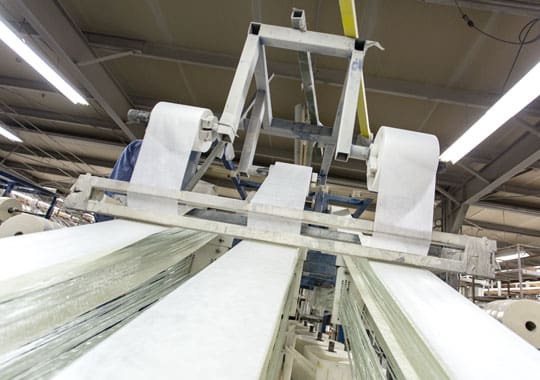Bedford Reinforced Plastics offers pultruded products to meet a variety of needs. In lieu of wood, steel or aluminum, fiberglass reinforced plastic (FRP) material is a sustainable, long-lasting product that is perfect for platforms, mezzanines, catwalks, walkways, fixed ladders, handrails, guardrails, stairs, bridges, structural shapes, grating and our custom FRP structures.
What is pultrusion?
 Pultrusion is the manufacturing process that creates continuous lengths of FRP. You may have also heard of molded FRP grating which uses a different process than pultruded FRP grating. Pultrusion produces a product where cross-sections are constant.
Pultrusion is the manufacturing process that creates continuous lengths of FRP. You may have also heard of molded FRP grating which uses a different process than pultruded FRP grating. Pultrusion produces a product where cross-sections are constant.
Literally, a pultrusion is what is known as a portmanteau word, or a combination of two or more words into a single new word. Pultrusion comes from the words “pull” and “extrusion.”
The pultrusion process is fairly new, with the first patent for pultrusion being issued in 1951. Many attribute pultrusion to plastic pioneer W. Brandt Goldsworthy, an honored member of the Plastics Academy Hall of Fame. Goldsworthy passed away in 2003, but the pultrusion process has continued to grow, develop and improve over the years.
What can pultruded materials be used for?
Pultrusion products created by Bedford Reinforced Plastics have been used for a wide array of requests. From the Bellagio fountains in beautiful Las Vegas, Nevada to a pedestrian bridge in the heart of New York City, materials formed through pultrusion can be found across the country and even the world.
Bedford Reinforced Plastics most generally offers their services to those seeking material that won’t corrode or warp in rough environments. FRP building material is both rot- and rust-proof and is known for being both lightweight and non-conductive.
How is pultrusion achieved?
The pultrusion process is achieved by a series of steps that are geared toward creating a quality FRP product. Bedford works to provide quality, durable and reliable products by following a rigorous process that promises a valuable end result.

Continuous fiberglass reinforcement: Rolls of filament or fabric work are used to keep strength across the profile of the product. This is what will be the starting base of the pultrusion. The material is fed into the machinery to begin the process.
Preforming guides: The material spools and reinforcements are threaded into a machine known as a tension roller. The roller will help to shape the pultrusions into what will soon become the finished product.
Impregnation and resin bath: The glass is now met with a resin mixture. The resin, sometime referred to as “wet-out,” will soak and permeate the unfinished product. This impregnating stage of the pultrusion may utilize different types of resin, such as polyester and vinylester. Pigments to add color and enhance the product’s appearance may also be added at this point. Catalysts that will assist in curing or solidifying the profile also find their way into the mix. This step is important in protecting the final product from corrosion, UV rays, and other impact issues.
Exposure to heat source: Now, it is time to turn up the heat. With the resin base now attached, the product enters a hot, steel-forming die. This hot die is pivotal to the pultrusion process as it creates the hard shape of the material.
Caterpillar pull mechanism and cutting saw: The cured profile is now advanced along a pull mechanism. The final step of the process is when the profile meets the cutting saw, where it is cut into appropriate lengths. This completes the pultrusion process and a finished fiberglass reinforced polymer is the final result.
Why pultrusion?
 Pultruded composite profiles have seen an increase in demand in recent years and for good reason. With the high durability and non-corrosive character traits of fiberglass reinforced polymers, it is a clear advantage to the customer to select a pultruded profile.
Pultruded composite profiles have seen an increase in demand in recent years and for good reason. With the high durability and non-corrosive character traits of fiberglass reinforced polymers, it is a clear advantage to the customer to select a pultruded profile.
The manufacturing process described above is also convenient, efficient and low-cost in comparison to other options on the market. The continuous process of pultrusion makes manufacturing cost-efficient and eco-friendly. Pultrusion also garners consistent high quality composites, reducing error in production and in turn offering a greater customer satisfaction.